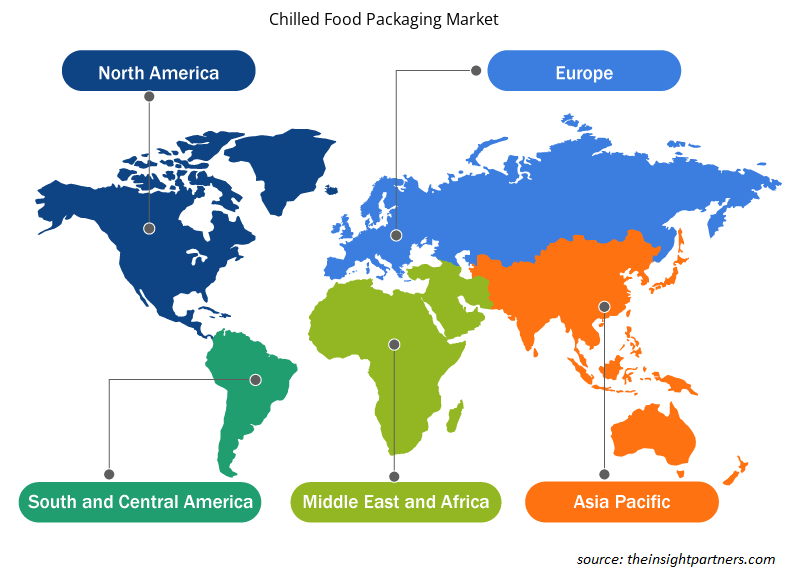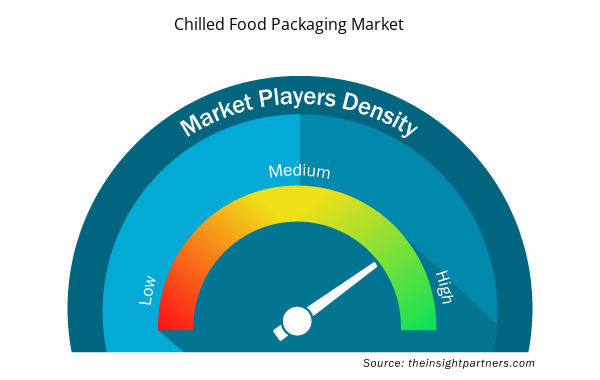[研究报告] 冷藏食品包装市场规模预计将从 2022 年的 129.4811 亿美元增长到 2030 年的 189.0273 亿美元;预计 2023 年至 2030 年的复合年增长率为 5.0%。
市场分析
全球冷藏食品包装市场是指需要冷藏来保持其质量和新鲜度的易腐食品的包装。市场包括一系列包装材料,例如塑料、纸和纸板、铝和木材,旨在使食品在运输和储存过程中保持低温。市场受到对方便食品日益增长的需求、城市化进程加快和生活方式改变的推动。食品安全和卫生意识的提高也推动了对冷藏食品包装的需求。此外,电子商务和网上杂货店购物的增长预计将在预测期内推动对冷藏食品包装的需求。
增长动力与挑战
有组织的零售和电子商务的扩张正在显著推动全球冷藏食品包装市场的增长。有组织的零售和电子商务平台为冷藏食品提供了更广泛的覆盖范围和更高的知名度。消费者越来越喜欢有组织的零售形式,因为它们提供便利性和广泛的产品。超市、大卖场和专卖店等有组织的零售店提供各种农产品、乳制品、肉类、海鲜、即食 (RTE) 食品等。在一个屋檐下拥有多种产品的便利性吸引了消费者,并鼓励他们选择有组织的零售而不是传统的零售形式。多样化的产品组合需要适当的包装,以确保产品的完整性、卫生性和在商店货架上的展示。此外,对方便或即食食品的需求增加进一步推动了全球冷藏食品包装市场的增长。高品质方便食品的消费量正在增加,这是目前食品行业最大的趋势之一。方便食品,如 RTE 产品,可以让消费者节省与购买食材、准备和烹饪饭菜、消费和餐后活动相关的时间和精力。这一食品领域的发展归因于许多社会变化;其中最显著的是全球小家庭数量的增加和千禧一代人口的增加。然而,与冷藏食品包装相关的严格政府法规可能会限制冷藏食品包装市场的增长。严格的政府法规会对冷藏食品包装施加某些限制。虽然这些法规的实施是为了确保消费者安全和环境可持续性,但它们可能会给包装制造商和供应商带来挑战和限制。遵守严格的规范通常需要在研究、测试、认证和持续合规监控方面投入大量资金。
定制此报告以满足您的需求
您可以免费定制任何报告,包括本报告的部分内容、国家级分析、Excel 数据包,以及为初创企业和大学提供优惠和折扣
- 获取此报告的关键市场趋势。这个免费样品将包括数据分析,从市场趋势到估计和预测。
报告分类和范围
“2030 年全球冷藏食品包装市场分析”是一项专业而深入的研究,主要关注全球冷藏食品包装市场趋势和增长机会。该报告旨在概述全球冷藏食品包装市场,并按材料、类型、应用和地域对市场进行详细细分。全球冷藏食品包装市场近年来一直保持高增长,预计在预测期内将继续保持这一趋势。该报告提供了全球冷藏食品包装消费量的关键统计数据以及主要地区和国家的需求。此外,该报告还对影响主要地区和国家冷藏食品包装市场表现的各种因素进行了定性评估。该报告还包括对冷藏食品包装市场主要参与者及其关键战略发展的全面分析。还包括对市场动态的几项分析,以帮助确定关键驱动因素、市场趋势和有利可图的冷藏食品包装市场机会,进而有助于确定主要收入来源。
此外,生态系统分析和波特五力分析提供了全球冷藏食品包装市场的360度视角,有助于了解整个供应链和影响市场增长的各种因素。
节段分析
全球冷藏食品包装市场根据材料、类型和应用进行细分。根据材料,冷藏食品包装市场分为塑料、铝、纸和纸板等。根据类型,冷藏食品包装市场分为盒子、桶和杯子、罐头、小袋和袋子等。根据应用,冷藏食品包装市场分为乳制品、肉类和家禽、海鲜、水果和蔬菜等。根据材料,塑料部分占全球冷藏食品包装市场的最大份额。塑料是包装冷藏产品的首选材料。塑料包装是一种灵活的包装形式,允许食品服务提供商根据客户的要求定制其形状、样式和尺寸。塑料包装在食品服务行业中很受欢迎,因为它重量轻。此外,用于食品包装的塑料包装产品易于运输。由于其耐用性和对外部影响的抵抗力,它们有助于保存冷藏包装食品。冷藏甜点、即食食品、乳制品、肉类、海鲜、意大利面食、家禽、水果和蔬菜通常用塑料或塑料基材料包装。根据类型,袋装和袋子部分在 2022 年占据了冷藏食品包装市场的最大份额。袋子和袋子由箔和食品级塑料等材料制成。它们主要用于包装冷冻蔬菜、肉类、海鲜和其他食品。它们因重量轻和紧凑而受到青睐。根据应用,乳制品部分在全球冷藏食品包装市场中占有相当大的份额。大多数乳制品都是易腐烂的。需要多种类型的包装概念来包装不同类型的乳制品。对不同乳制品的需求导致了工艺和包装概念的改进,从而显着提高了乳制品在冷链配送中的保质期。包装冷藏食品是为了保持食品新鲜并防止外部因素,例如温度变化、水分和蒸汽。这将进一步为整个行业增长吸引新的增长机会。
区域分析
报告详细概述了全球冷藏食品包装市场,涵盖五大主要地区——北美、欧洲、亚太地区 (APAC)、中东和非洲 (MEA) 以及南美和中美。中东和非洲占据了相当大的市场份额;2022 年中东和非洲的市场价值超过 7 亿美元,预计在预测期内将出现可观的增长。电子商务的快速增长为中东和非洲的市场增长做出了积极贡献。亚太地区也经历了可观的增长;由于电子商务和有组织的零售对冷藏食品包装的需求不断增加,该市场预计到 2030 年将达到 50 亿美元以上。北美冷藏食品包装市场的复合年增长率预计将超过 5%;人们对即食食品的偏好增加预计将进一步推动北美冷藏食品包装市场的增长。
行业发展和未来机遇
合作、收购和新产品发布被发现是全球冷藏食品包装市场参与者所采用的主要策略。
2023 年 5 月,Graphic Packaging 与 Cranswick Plc 合作,为 Tesco Plc 商业化可回收 PaperLite 包装。
2020 年 4 月,Elopak 和 GLS 宣布成立合资公司,两家公司各占 50% 的股份。新成立的公司 GLS Elopak 将利用 Elopak 和 GLS 的专业知识、资产和网络,充分利用印度巨大的消费需求。
冷藏食品包装市场区域洞察
Insight Partners 的分析师已详尽解释了预测期内影响冷藏食品包装市场的区域趋势和因素。本节还讨论了北美、欧洲、亚太地区、中东和非洲以及南美和中美洲的冷藏食品包装市场细分和地理位置。

- 获取冷藏食品包装市场的区域特定数据
冷藏食品包装市场报告范围
| 报告属性 | 细节 |
|---|---|
| 2022 年市场规模 | 129.5亿美元 |
| 2030 年市场规模 | 189亿美元 |
| 全球复合年增长率(2022 - 2030 年) | 5.0% |
| 史料 | 2020-2021 |
| 预测期 | 2023-2030 |
| 涵盖的领域 | 按材质
|
| 覆盖地区和国家 | 北美
|
| 市场领导者和主要公司简介 |
|
冷藏食品包装市场参与者密度:了解其对业务动态的影响
冷藏食品包装市场正在快速增长,这得益于终端用户需求的不断增长,而这些需求又源于消费者偏好的不断变化、技术进步以及对产品优势的认识不断提高等因素。随着需求的增加,企业正在扩大其产品范围,进行创新以满足消费者的需求,并利用新兴趋势,从而进一步推动市场增长。
市场参与者密度是指在特定市场或行业内运营的企业或公司的分布情况。它表明在给定市场空间中,相对于其规模或总市场价值,有多少竞争对手(市场参与者)存在。
在冷藏食品包装市场运营的主要公司有:
- 蒙迪公司
- 安姆科公司
- Sealstrip 公司
- 索诺科产品公司
- 阿默普拉斯特有限公司
免责声明:上面列出的公司没有按照任何特定顺序排列。

- 了解冷藏食品包装市场主要参与者概况
新冠疫情的影响/地缘政治形势的影响/经济衰退的影响
COVID-19 疫情导致全球许多行业的发展放缓。全球制造工厂的关闭和贸易限制导致全球制造商的供应链受限。COVID-19 疫情对化学品和材料行业以及冷藏食品包装市场的增长产生了不利影响。为抗击 SARS-CoV-2 传播而采取的措施阻碍了不同行业的发展。由于工厂关闭、运输限制和劳动力短缺,疫情导致全球供应链中断。这些动荡影响了原材料和包装组件的供应,导致潜在的供应链延迟和冷藏食品包装制造商的运营成本增加。原材料的稀缺和运输费用的增加导致生产成本上升。此外,由于封锁和社交疏离措施,包括餐馆、咖啡馆和餐饮服务在内的食品服务业的需求急剧下降。这种下降直接影响了食品服务业务对冷藏食品及其相关包装的需求。因此,食品服务行业的包装材料制造商面临订单减少和收入损失。尽管如此,冷藏食品包装市场已从疫情后恢复得相当好,预计未来几年将继续增长。
竞争格局和主要公司
冷藏食品包装市场的一些主要参与者包括 Mondi Plc;Amcor Plc;Sealstrip Corp;Sonoco Products Co;Amerplast Ltd;Berry Global Group Inc;Westrock Co;Graphic Packaging Holding Co;Tetra Pak International SA 和 Sealed Air Corp。
- 历史分析(2 年)、基准年、预测(7 年)及复合年增长率
- PEST 和 SWOT 分析
- 市场规模价值/数量 - 全球、区域、国家
- 行业和竞争格局
- Excel 数据集



Report Coverage
Revenue forecast, Company Analysis, Industry landscape, Growth factors, and Trends

Segment Covered
This text is related
to segments covered.

Regional Scope
North America, Europe, Asia Pacific, Middle East & Africa, South & Central America

Country Scope
This text is related
to country scope.
常见问题
The major players operating in the global chilled food packaging market are Mondi Plc; Amcor Plc; Sealstrip Corp; Sonoco Products Co; Amerplast Ltd; Berry Global Group Inc; Westrock Co; Graphic Packaging Holding Co; Tetra Pak International SA; and Sealed Air Corp.
North America accounted for the largest share of the global chilled food packaging market. North America is one of the most significant regions for the chilled food packaging market owing to drastic increase in the consumption of ready-to-eat food.
Organized retail and e-commerce platforms provide a broader reach and greater visibility for chilled food products. Consumers increasingly prefer organized retail formats due to the convenience and wide range of products they offer. Organized retail, such as supermarkets, hypermarkets, and specialty stores, offers a wide range of produce, dairy products, meat, seafood, ready-to-eat (RTE) meals, and more. The convenience of having multiple products under one roof attracts consumers and encourages them to choose organized retail over traditional retail formats. The diverse product assortment requires appropriate packaging to ensure product integrity, hygiene, and presentation on store shelves. dditionally, chilled food packaging helps extend the shelf life of perishable products by providing protective barriers against oxygen, moisture, and contaminants. Hence, retailers can stock various chilled food items for longer periods, lowering the risk of spoilage and minimizing product waste. Proper packaging enables retailers to offer fresh and high-quality products to consumers.
Consumers demand safe and low-processed food; thus, chilled food packaging players are making significant changes in packaging solutions. Also, there are growing environmental concerns. In Canada, many cities have banned the distribution of polystyrene foam cups and containers because end users are seeking sustainable solutions. Vancouver (Canada) also restricts plastic shopping bags and disposable cups. The Canadian packaging industry promotes major food packaging projects aiming to ensure 100% recyclable, reusable, or compostable packaging solutions. Further, eco-friendly packaging helps protect human health and the environment and maintain natural resources. Ideal packaging material should possess recycling properties, serving as a viable solution for ecological issues. Food service packaging companies are seeking ways to recycle as part of their efforts toward finding sustainable food packaging solutions.
Based on the application, meat and poultry segment is projected to grow at the fastest CAGR over the forecast period. Meat and poultry foods are perishable products, and the packaging of chilled meat and poultry products is crucial in food safety programs. Atmosphere-appropriate packaging is widely used for protecting chilled meat and poultry products. Beef, lamb, pork, and chicken must be kept below +5°C. Plastic bags, cartons, wraps, and films are majorly utilized for packaging meat and poultry products.
Based on material, plastic segment mainly has the largest revenue share. The growth of the segment is attributed to the excellent properties of the plastic as packaging material. Plastic is the most preferred material for packaging refrigerated products. Plastic packaging is a flexible form of packaging, allowing food service providers to customize its shape, style, and size as per customers’ requirements. Plastic packaging is preferred in the food service industry since it is lightweight.
The List of Companies - Chilled Food Packaging Market
- Mondi Plc
- Amcor Plc
- Sealstrip Corp
- Sonoco Products Co
- Amerplast Ltd
- Berry Global Group Inc
- Westrock Co
- Graphic Packaging Holding Co
- Tetra Pak International SA
- Sealed Air Corp
The Insight Partners performs research in 4 major stages: Data Collection & Secondary Research, Primary Research, Data Analysis and Data Triangulation & Final Review.
- Data Collection and Secondary Research:
As a market research and consulting firm operating from a decade, we have published and advised several client across the globe. First step for any study will start with an assessment of currently available data and insights from existing reports. Further, historical and current market information is collected from Investor Presentations, Annual Reports, SEC Filings, etc., and other information related to company’s performance and market positioning are gathered from Paid Databases (Factiva, Hoovers, and Reuters) and various other publications available in public domain.
Several associations trade associates, technical forums, institutes, societies and organization are accessed to gain technical as well as market related insights through their publications such as research papers, blogs and press releases related to the studies are referred to get cues about the market. Further, white papers, journals, magazines, and other news articles published in last 3 years are scrutinized and analyzed to understand the current market trends.
- Primary Research:
The primarily interview analysis comprise of data obtained from industry participants interview and answers to survey questions gathered by in-house primary team.
For primary research, interviews are conducted with industry experts/CEOs/Marketing Managers/VPs/Subject Matter Experts from both demand and supply side to get a 360-degree view of the market. The primary team conducts several interviews based on the complexity of the markets to understand the various market trends and dynamics which makes research more credible and precise.
A typical research interview fulfils the following functions:
- Provides first-hand information on the market size, market trends, growth trends, competitive landscape, and outlook
- Validates and strengthens in-house secondary research findings
- Develops the analysis team’s expertise and market understanding
Primary research involves email interactions and telephone interviews for each market, category, segment, and sub-segment across geographies. The participants who typically take part in such a process include, but are not limited to:
- Industry participants: VPs, business development managers, market intelligence managers and national sales managers
- Outside experts: Valuation experts, research analysts and key opinion leaders specializing in the electronics and semiconductor industry.
Below is the breakup of our primary respondents by company, designation, and region:

Once we receive the confirmation from primary research sources or primary respondents, we finalize the base year market estimation and forecast the data as per the macroeconomic and microeconomic factors assessed during data collection.
- Data Analysis:
Once data is validated through both secondary as well as primary respondents, we finalize the market estimations by hypothesis formulation and factor analysis at regional and country level.
- Macro-Economic Factor Analysis:
We analyse macroeconomic indicators such the gross domestic product (GDP), increase in the demand for goods and services across industries, technological advancement, regional economic growth, governmental policies, the influence of COVID-19, PEST analysis, and other aspects. This analysis aids in setting benchmarks for various nations/regions and approximating market splits. Additionally, the general trend of the aforementioned components aid in determining the market's development possibilities.
- Country Level Data:
Various factors that are especially aligned to the country are taken into account to determine the market size for a certain area and country, including the presence of vendors, such as headquarters and offices, the country's GDP, demand patterns, and industry growth. To comprehend the market dynamics for the nation, a number of growth variables, inhibitors, application areas, and current market trends are researched. The aforementioned elements aid in determining the country's overall market's growth potential.
- Company Profile:
The “Table of Contents” is formulated by listing and analyzing more than 25 - 30 companies operating in the market ecosystem across geographies. However, we profile only 10 companies as a standard practice in our syndicate reports. These 10 companies comprise leading, emerging, and regional players. Nonetheless, our analysis is not restricted to the 10 listed companies, we also analyze other companies present in the market to develop a holistic view and understand the prevailing trends. The “Company Profiles” section in the report covers key facts, business description, products & services, financial information, SWOT analysis, and key developments. The financial information presented is extracted from the annual reports and official documents of the publicly listed companies. Upon collecting the information for the sections of respective companies, we verify them via various primary sources and then compile the data in respective company profiles. The company level information helps us in deriving the base number as well as in forecasting the market size.
- Developing Base Number:
Aggregation of sales statistics (2020-2022) and macro-economic factor, and other secondary and primary research insights are utilized to arrive at base number and related market shares for 2022. The data gaps are identified in this step and relevant market data is analyzed, collected from paid primary interviews or databases. On finalizing the base year market size, forecasts are developed on the basis of macro-economic, industry and market growth factors and company level analysis.
- Data Triangulation and Final Review:
The market findings and base year market size calculations are validated from supply as well as demand side. Demand side validations are based on macro-economic factor analysis and benchmarks for respective regions and countries. In case of supply side validations, revenues of major companies are estimated (in case not available) based on industry benchmark, approximate number of employees, product portfolio, and primary interviews revenues are gathered. Further revenue from target product/service segment is assessed to avoid overshooting of market statistics. In case of heavy deviations between supply and demand side values, all thes steps are repeated to achieve synchronization.
We follow an iterative model, wherein we share our research findings with Subject Matter Experts (SME’s) and Key Opinion Leaders (KOLs) until consensus view of the market is not formulated – this model negates any drastic deviation in the opinions of experts. Only validated and universally acceptable research findings are quoted in our reports.
We have important check points that we use to validate our research findings – which we call – data triangulation, where we validate the information, we generate from secondary sources with primary interviews and then we re-validate with our internal data bases and Subject matter experts. This comprehensive model enables us to deliver high quality, reliable data in shortest possible time.


 获取此报告的免费样本
获取此报告的免费样本